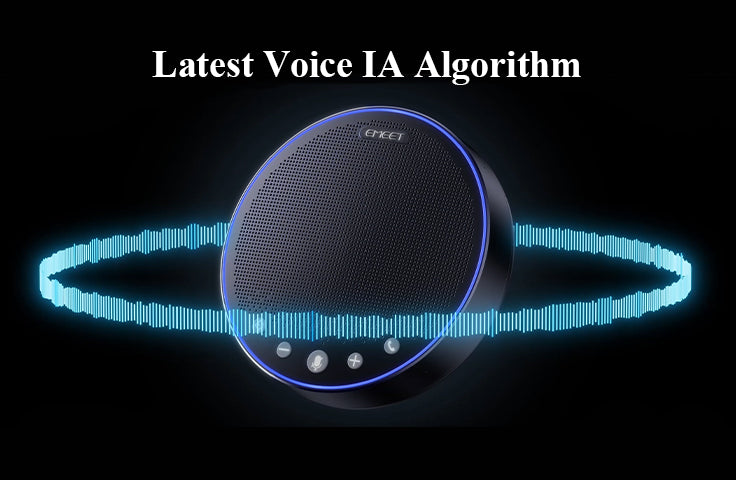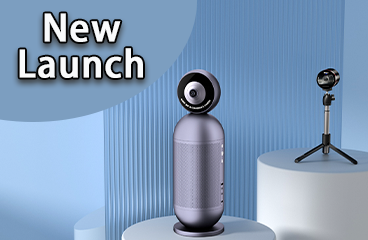Voice IA Algorithm is an EMEET independent research and development acoustic technique. Turning on VoiceIA noise reduction can greatly reduce some noises during meetings, such as keyboard tapping, air conditioning noise, and general unwanted background noise. It can offer crystal-clear audio when you call. The core technologies include:
1. Speech Recognition - Separating the speech from the received signal and processing these signals with pre-designed rules to identify the sound and give feedback on the result to the user.
2. Noise Cancellation - Increase the transient noise suppression function of a single deep learning conference room scene, including common mouse, keyboard, air conditioner, table and chair movement and other noises.
3. Full-Duplex - Data is transmitted simultaneously between connected systems; the most famous example of a full-duplex channel is telephony, in which both participants can hear and speak at the same time.
4. De-reverberation - Adds deep learning to reverberation function.
5. Auto Enhancement - Dynamic gain control with deep learning VAD.
Out of the five core technologies, the most vital technology in Voice IA Algorithm is speech recognition. Let's take a deeper review of this technology.
What is Speech Recognition?
It is a technology for automatically processing speech signals, which determines the relationship in the data through data analysis and reasoning to realize automatic operation. Its purpose is to separate the speech from the received signal and process these signals with pre-designed rules to identify the sound and give feedback on the result to the user. Speech recognition technology is widely used in communication, broadcasting, military, medical, navigation, automatic control and many other fields. The modern speech recognition system is mainly composed of three parts: acoustic model algorithm and its parameter optimization processing, fuzzy neural network, language model and prediction algorithm.
Acoustic models and fuzzy neural networks are the two main types of fuzzy neural networks. The acoustic model algorithm is a recognition technology based on statistical probability estimation theory, which is of great significance in signal detection and feature extraction. At the same time, a fuzzy neural network performs nonlinear processing on unclear data so that it can accurately reflect human speech. The speech training algorithm includes two processes of speech generation and testing: after the speech signal is preprocessed at the input end, it is first sent to the speech generation system for language model (speaker) training; then, the trained language model is sent to the test the system is tested. The test results are generally output from the input terminal and serve as the basis for the performance of the speech recognition system.
Speech recognition technology can be divided into two categories: one is to extract signal features by statistical methods, such as the Hidden Markov method and Kalman filter, etc.; the other is to judge whether features match based on rule reasoning, such as neural networks and fuzzy pattern recognition etc. Therefore, what we call language recognition is also called language or speech recognition.
Hidden Markov Model
Hidden Markov Model is a statistical model that represents each observed input sequence with a state sequence, and each state has a corresponding probability associated with the input. The basic idea of the model is that if there is a set of continuous variables, one observation can predict the next set of continuous variables. Because when modelling the system, it is optional to know all the states of the system, but only part of the states. This structure plays a significant role in system modelling:
1. It provides a good language model for multiple inputs and a single output.
2. It can describe the correlation between speech signals and noise well.
3. It is widely used in many different types of languages.
Speech Recognition:
1. It refers to matching according to the predicted pattern and marked feature parameters in a given input sequence.
2. After training, each word in the input sequence is used as an independent part to describe the speaker, and the corresponding text is recognized according to this independent part.
Kalman Filtering
Kalman filtering is a new method which estimates the noise by setting a statistical noise model and then applies the Kalman filtering method to achieve speech enhancement. Speech Enhancement Algorithm Based on Kalman Filter, Algorithm Realization In this paper, a computer is used to simulate the influence of noise on the noisy speech signal in the actual environment, and on this basis, a speech enhancement method based on the combination of Kalman filter algorithms and spectral subtraction is implemented. The algorithm first uses the noisy and noisy signals to form two independent models in time and space, respectively, then uses the noisy signal as the noise variance and performs Kalman filter calculation on it.
Finally uses the spectral subtraction method to process the noisy signal for enhancement. The simulation test and analysis of the algorithm are realized on the Matlab platform. Combining Kalman filtering and spectral subtraction, a speech enhancement algorithm based on Kalman filtering is proposed. This method can significantly improve the system's robustness and suppress the interference of noise in the system.
Why Use Voice IA Algorithm in Conference Equipment?
As we explained, the principle of the voice IA algorithm is based on the Hidden Markov Mode and Kalman filtering. The voice IA algorithm can facilitate natural full-duplex communication in speakerphones by suppressing echo and acoustic feedback, enabling clear speech conversations even in noisy environments. For instance, when you conduct online audio meetings with a vital client, but your office room has terrible noise cancellation, the client might have trouble hearing your voice. The voice IA algorithm within the conference speakerphone can eliminate over 200 types of background noises and enhance your voice, so the client can listen to you clearly and not mess up this crucial meeting. There are a lot of conference speakerphones that have the voice IA algorithm installed. Still, the EMEET OfficeCore M3 Speakerphone and EMEET OfficeCore M2 Max Speakerphone have installed the latest voice IA 4.2 algorithm, making their product much more outstanding than other competitors.


